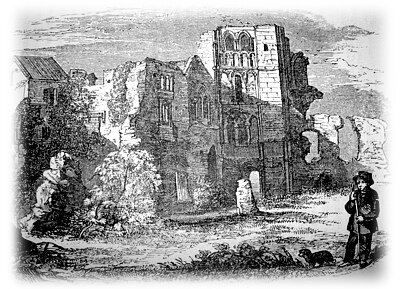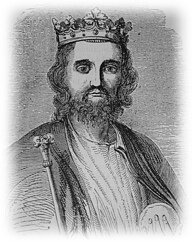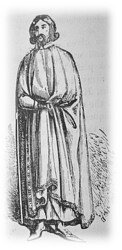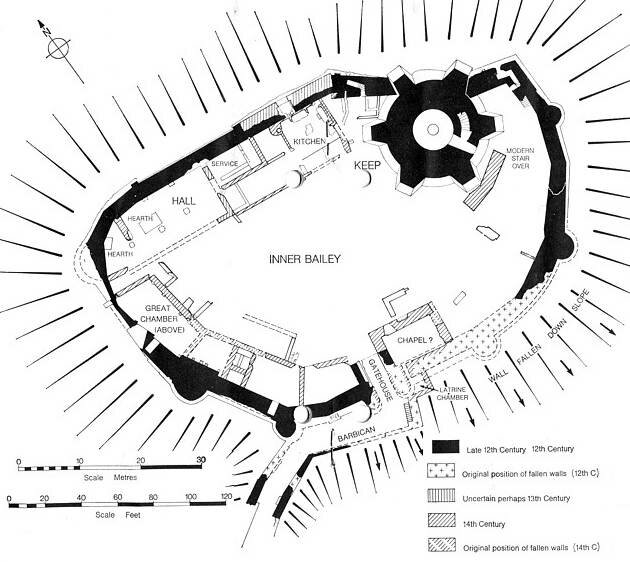Conisbrough Castle
History
The Britons called Conisbrough Kaer-Conan which signifies, the City of a King. Aurelius Ambrosius, a British prince, after defeating the Saxons in a battle in 489, retired to Kaer- Conan with his prisoners; and there it was that Hengist, the Saxon general, was beheaded and buried
The modern name Conisbrough is probably only an altered form of the Anglo-Saxon Cyningesburh, meaning the king’s burh (burhs were Saxon defended sites built for the most part against the Danes).
To which king this refers is uncertain but a document of 1002 shows that Conisbrough was not then a royal estate.
The Domesday Book, however, records that at the time of the Conquest the manor was held by King Harold.
It is likely that the earth and timber defences of the pre-Conquest burh surrounded the church on the opposite hill.

At the time of Domesday Book, Conisbrough formed part of the extensive and widely scattered estates held by William de Warenne, the first Norman Earl of Surrey, who had come to England with the Conqueror and fought beside him at Hastings.
No doubt the Honour of Conisbrough like his other Honours of Lewes, in Sussex, and Castle Acre, in Norfolk, was part of his reward for these services. An honour in this sense was a feudal estate usually centred on a castle,and it was probably Earl William who laid out and shaped the earth works of the castle as we now see them. At first they would have been crowned by heavy timber palisades, with towers and buildings of timber construction also.
 Earl William died in 1088 and was succeeded by his son (1088 - 1138) and later by his grandson (1138 - 47), both called William. The third earl left no sons but only a daughter, Isabel, who inherited Conisbrough. Her first husband, William of Blois, became the fourth earl and after his death in 1159 she married in 1163 the illegitimate half-brother of Henry II, Hamelin Plantagenet, who held the earldom until his death in 1202.
Earl William died in 1088 and was succeeded by his son (1088 - 1138) and later by his grandson (1138 - 47), both called William. The third earl left no sons but only a daughter, Isabel, who inherited Conisbrough. Her first husband, William of Blois, became the fourth earl and after his death in 1159 she married in 1163 the illegitimate half-brother of Henry II, Hamelin Plantagenet, who held the earldom until his death in 1202.
Hamelin spent less time abroad than his predecessors (the third earl for example, died on Crusade) and it was probably he who transformed Conisbrough into the great stone-built castle whose ruins are so impressive today. It is likely that the keep was built at his order in c. 1180 - 90, and probably the curtain wall followed very shortly afterwards. The first two written references to the castle are of about this date; an endowment of fifty shillings a year for a chapel in the castle by Hamelin and Isabel, and the occurrence of its name in a list of castles compiled at this time. King John issued a charter at Conisbrough in 1201 and may well have lodged in the keep.
 Hamelin was succeeded in 1202 by his son William, the sixth earl (1202—39). After his death in 1239, the manor passed to his son, John, then a child. John’s son was killed at a tournament, so that he was succeeded by his grandson, John, the eighth and last earl (1304 - 47), also a child at the time of his inheritance. He abducted the Countess Alice, wife of Earl Thomas of Lancaster, who retaliated by attacking and seizing Earl John’s Yorkshire castle. Earl Thomas had control of Conisbrough Castle from 1317 until after his abortive rebellion against Edward II which led to his execution in March, 1322. The King retained Conisbrough together with several other of Thomas’s Yorkshire castles for several years. Edward II stayed there for a few days early in November 1322, and several royal orders from the King to the constable during the next years are extant, including one authorising the expenditure of up to forty marks on repairs to the walls and towers of Sandal and Conisbrough Castles. The latter was restored to Earl John in 1326 but his ownership did not become secure until the early years of Edward III.
Hamelin was succeeded in 1202 by his son William, the sixth earl (1202—39). After his death in 1239, the manor passed to his son, John, then a child. John’s son was killed at a tournament, so that he was succeeded by his grandson, John, the eighth and last earl (1304 - 47), also a child at the time of his inheritance. He abducted the Countess Alice, wife of Earl Thomas of Lancaster, who retaliated by attacking and seizing Earl John’s Yorkshire castle. Earl Thomas had control of Conisbrough Castle from 1317 until after his abortive rebellion against Edward II which led to his execution in March, 1322. The King retained Conisbrough together with several other of Thomas’s Yorkshire castles for several years. Edward II stayed there for a few days early in November 1322, and several royal orders from the King to the constable during the next years are extant, including one authorising the expenditure of up to forty marks on repairs to the walls and towers of Sandal and Conisbrough Castles. The latter was restored to Earl John in 1326 but his ownership did not become secure until the early years of Edward III.
 John died in 1347 without an heir, and Conisbrough reverted to the Crown. Edward III issued a royal patent in the same year conferring the estates upon his youngest son, Edmund Langley.As he was then a child, the estate was administered by his mother, Queen Philippa.
John died in 1347 without an heir, and Conisbrough reverted to the Crown. Edward III issued a royal patent in the same year conferring the estates upon his youngest son, Edmund Langley.As he was then a child, the estate was administered by his mother, Queen Philippa.

Edmund was created Earl of Cambridge and later Duke of York by Richard II. His son, Edward, Duke of Albemarle, succeeded him in 1402 and was killed at Agincourt. He had a younger brother, Richard, Earl of Cambridge, who was probably born at Conisbrough; and although he had been beheaded for treason earlier in the same year, 1415, the castle was held in dower for many years by Richard’s widow, who is known to have lived there.
From her death in 1446, the castle seems to have gone slowly out of use. Her stepson Richard, Duke of York, then entered into possession. After his death at the Battle of Wakefield in 1460 his son succeeded him, and when in the next year he became Edward IV the estate returned to the Crown. In 1495 Edmund Langley’s settlement was annexed in perpetuity to the Crown, but in Henry Vi reign Conisbrough was granted to the Carey family, who retained it for many years.
It is not necessary to trace the history further, for by Tudor times the castle was ruinous. A survey of January 1538, records that the gates and bridge had fallen down, as well as l80ft (55m) of curtain wall, although the keep retained its floors except for one which had fallen in. Visitors can be grateful for Conisbrough’s decline in the fifteenth century, for it was incapable of defence in the Civil War, and thus the great keep was saved from the bombardment and slight by Parliamentary forces that befell many castles. Finally, mention must be made of Sir Walter Scott’s Ivanhoe , a novel that has carried the fame of the Saxon fortress at Conisbrough all over the world. Visitors should remember that the events enacted at the castle and most of the persons (including Athe of Conisbrough) are fictitious, and that although Scott’s picture of the castle in the time of Richard I is probably broadly true the keep was then freshly built and not centuries old.
Description
The modern gate by the custodian’s cottage is probably on the site of the original entry into the outer ward, an enclosure on the west side of the main castle defended only by a bank and ditch. On the left the bank is visible and can be traced round to the point where it joins the ditch of the main inner ward. On the right it has been cut into by the building but can be followed beyond this.A path leads eastwards to the inner ward and the main castle - tIdings, set on a natural hill whose steep sides have been steepened either by scarping and the cutting of a deep surrounding ditch. The material from this was thrown outwards to form a large counter scarp bank. The present causeway across the ditch occupies the site of an earlier drawbridge. Beyond are two projecting parallel walls, the gap between them being formerly closed by gates. The northern wall joined the semi-circular turret that projects from the curtain, the southern bears to the right and formerly continued parallel to the curtain to cover the main entry to the castle. The constricted passage so formed is known as a barbican and its purpose was to control access and give added protection to the gate, always the weakest point in a castle’s defences. It was commanded from the top of the adjacent turret, from the curtain wall-walk and possibly from the top of the barbican walls as well. The barbican is of the same build as the curtain or only slightly later; the quoins are treated in the same manner in both. On the left, where the barbican originally ended, is the entry to the ward. It was flanked by a pair of turrets and led into a square internal gate-tower of which the eastern flanking wall was extended inwards to cover the west end of a building, perhaps a chapel. But almost the whole of the gateway, with a length of curtain to the east, has slid down the hillside. The break came through the middle of the left-hand turret, the site of which is marked in the modern path approaching the entrance to the bailey. What little remains in position of this turret, with part of the plinth, is of the original build. But the large mass of the right-hand turret that be seen where it fell, at the bottom of the slope, shows that the inner faces of the turrets and the entrance-arch, with the terminal wall of the barbican, were rebuilt in large ashlar in the fourteenth century, when a western stretch of the curtain was rebuilt in similar manner. This was perhaps the work of the last of the Warennes, about 1340. The sloping plinth, or glacis, of the turret is magnificent and crowned by a very advanced-looking projected weathering-course, but with a true decorated scroll-moulding on top.
The Inner Ward is an oval enclosure defended by a tall curtain wall set on the edge of the hillside. Apart from rebuilt stretches on the west and north, which have an outer facing of ashlar, the whole curtain is of rubble with a roughly coursed face. It is set out in short straight lengths, the angles of junction being bonded with ashlar blocks. On the outside three features are specially worthy of notice. First, except for a short length, the wall base is strongly splayed and this is carried round the bases of the towers. This was done to increase stability and also to cause stone ammunition dropped from above to ricochet on to the enemy below. Secondly, on the south face, that is to say along the weaker side of the castle, solid semi circular turrets of different sizes project or projected at intervals from the curtain face. Three survive and there were evidently six the positions shown on the plan. They rose above the wall-walk, whence steps led to their summits, as the two well-preserved examples on the west show. Their purpose was to bring an enemy attacking the curtain into full field of fire, which could not be done from the wall-walk without the defender exposing himself. They show perhaps the earliest use of round towers for that purpose in this country, but the similar, solid towers, at Scarborough must be of much the same date. In the later twelfth century such projecting towers were usually square; in the thirteenth century the use of round towers became general, but in either case they were normally hollow-built and contained rooms. Thirdly, the northern face of the curtain, where there are no towers, was strengthened by three ashlar-faced pilaster buttresses.
The principal domestic buildings of the castle were set against the inner face of the curtain. Many of their foundations are visible and, in the wall itself, the joist-holes for their floor beams and corbels for their roof timbers. Their general plan and disposition are fairly clear although they include work of several periods—all of them remarkably casual in plan and common in construction, compared with the princely finesse of the keep or the later entrance. They were largely of timber and the roofs were often carried on posts set on padstones, set in or against the walls. Immediately on left inside the gate lies a range of domestic buildings, probably with the main living area at first-floor level. The deep shaft, probably in origin a natural fissure in the rock, served these apartments as a latrine. The later hall lay on the north-west side of the bailey; it was a four-bayed building, about 70ft (2lm) long, with a single aisle on the south side and a central, open hearth, apparently superseding a wall- fireplace. The services extended eastward, with the kitchen near the keep. The chamber was to the south-west and had, perhaps, more grandeur, as it led to well-lighted oriel in the rebuilt western part of the curtain. On either side of the keep are garderobes, or privies, set in the thickness of the curtain below steps leading to the wall-walk.
Finally visitors may turn to the Keep, a magnificent building still largely intact and one of the finest surviving pieces of twelfth century secular architecture in the country. The curtain wall is not bohded into it and it is clear that the keep was built first, with the curtain probably following after only a very short interval. Neither can be dated by documentary evidence, but the decorative mouldings in the keep chapel suggest a date of 1180 - 90. For this reason its construction is attributed to Hamelin Plantagenet, holder of the castle from 1163 to 1202.
Seen from the outside the keep is a cylindrical tower with a splayed base clasped by six wedge-shaped buttresses also with splayed bases. These buttresses are so large that they are in effect turrets and indeed they rise as such above the level of the top of the keep proper. The whole building is faced with very finely worked ashlar blocks of varying size regularly coursed and between the buttresses dressed to the curve.

As with most Norman keeps the entry was on the first floor, level with the wall-walk of the curtains. The door was reached by a flight of stone steps at right angles to it, the gap at the top being spanned by a movable bridge. The lower courses of the original work are to be seen at the base of the modern staircase. The doorway has a joggled lintel below a segmental relieving arch; the door was secured by two bars, the sockets for which remain. A widening vaulted passage through the l5ft (4.6m) thickness of the wall leads to the first-floor room. This was originally unlit except by the light from the open door. The circular aperture in the centre of the floor is still the only access to an unlit vaulted room below. The well in the centre of the ground-floor room is now choked up. Buckets could be lowered into it from the ground and first floors and possibly from some of the higher floors also. Both these dark lower rooms were probably used for storage. Looking up, visitors can see that the upper rooms become successively larger on account of the offsets which formerly carried their floor timbers.
A wide vaulted stairway on the east side of the entry passage two splayed lights and leads to the principal room in the keep - the lord’s camera or great chamber. The room is dominated on the north side by a great hooded fireplace with joggled lintel resting on triple-clustered columns with decorated capitals. Next to this is a recessed layer or wash-basin and opposite is a small doorway leading to a garderobe and a large vaulted window recess with stone benches and a window with two rectangular lights.
The doorway to the staircase. leading to the top floor is placed opposite the entry, partly perhaps in order not to weaken the wall of the keep by having too much hollowness on one side. This stair case is vaulted and lit by two lights large enough to serve also as archer’s slits. The third-floor room served as the lord’s private retiring room and bedchamber. The fireplace is similar to the one below but smaller. Above it can be seen the base of the chimney - stack for them both. On the west side is a window also similar to that below, on the east a basin in a trefoil-headed recess. To the right of the entry a flat-headed door leads into the chapel. This is set in the thickness of one of the buttresses, from which it takes its elongated hexagonal plan. At its east is a round-headed slit window decorated with a roll moulding and set beneath a round arch decorated with chevrons which rests on small edged columns with moulded capitals. On either side are circular apertures containing quatrefoil lights decorated with pellets on the outside (these are visible only from the ground). The vaulted roof is divided into two unequal parts by an edged semi-circular rib with deep chevron mouldings and resting on either side on columns with decorated capitals. The two compartments have diagonal ribs with moulded bosses at the intersections and they rest on shafts with decorated capitals at each end of the chapel and on moulded corbels in the middle. On the north and south sides are piscinas with trefoil heads, and in the north-west corner a doorway leads into a small sacristy lit by a single window and containing a trefoil-headed recess.
From a doorway on the east side of the third-floor room a vaulted staircase, at the foot of which is a garderobe, leads to the wall-walk and parapet at the top of the tower. The keep had a conical roof, the floor-space of which rested on the corbels that are visible round the whole circumference of the wall top. The tops of the buttresses rise above this level as turrets, reached by steps which in one place partly remain. Four of the buttresses were hollow, one containing a pigeon loft, another an oven and the other two, cisterns for water. The top of the keep commands a fine view of the surrounding countryside and of the internal arrangements of the castle.
Source Brochure by M. W. Thompson, Principal Inspector of Ancient Monuments . 1971.
